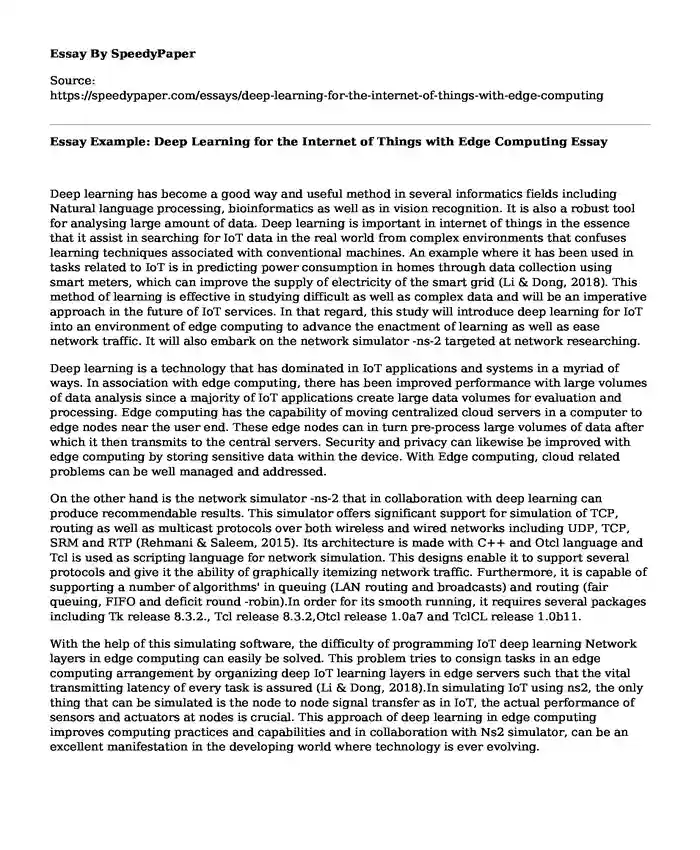
| Type of paper: | Research paper |
| Categories: | Internet Computer science |
| Pages: | 3 |
| Wordcount: | 600 words |
Deep learning has become a good way and useful method in several informatics fields including Natural language processing, bioinformatics as well as in vision recognition. It is also a robust tool for analysing large amount of data. Deep learning is important in internet of things in the essence that it assist in searching for IoT data in the real world from complex environments that confuses learning techniques associated with conventional machines. An example where it has been used in tasks related to IoT is in predicting power consumption in homes through data collection using smart meters, which can improve the supply of electricity of the smart grid (Li & Dong, 2018). This method of learning is effective in studying difficult as well as complex data and will be an imperative approach in the future of IoT services. In that regard, this study will introduce deep learning for IoT into an environment of edge computing to advance the enactment of learning as well as ease network traffic. It will also embark on the network simulator -ns-2 targeted at network researching.
Deep learning is a technology that has dominated in IoT applications and systems in a myriad of ways. In association with edge computing, there has been improved performance with large volumes of data analysis since a majority of IoT applications create large data volumes for evaluation and processing. Edge computing has the capability of moving centralized cloud servers in a computer to edge nodes near the user end. These edge nodes can in turn pre-process large volumes of data after which it then transmits to the central servers. Security and privacy can likewise be improved with edge computing by storing sensitive data within the device. With Edge computing, cloud related problems can be well managed and addressed.
On the other hand is the network simulator -ns-2 that in collaboration with deep learning can produce recommendable results. This simulator offers significant support for simulation of TCP, routing as well as multicast protocols over both wireless and wired networks including UDP, TCP, SRM and RTP (Rehmani & Saleem, 2015). Its architecture is made with C++ and Otcl language and Tcl is used as scripting language for network simulation. This designs enable it to support several protocols and give it the ability of graphically itemizing network traffic. Furthermore, it is capable of supporting a number of algorithms' in queuing (LAN routing and broadcasts) and routing (fair queuing, FIFO and deficit round -robin).In order for its smooth running, it requires several packages including Tk release 8.3.2., Tcl release 8.3.2,Otcl release 1.0a7 and TclCL release 1.0b11.
With the help of this simulating software, the difficulty of programming IoT deep learning Network layers in edge computing can easily be solved. This problem tries to consign tasks in an edge computing arrangement by organizing deep IoT learning layers in edge servers such that the vital transmitting latency of every task is assured (Li & Dong, 2018).In simulating IoT using ns2, the only thing that can be simulated is the node to node signal transfer as in IoT, the actual performance of sensors and actuators at nodes is crucial. This approach of deep learning in edge computing improves computing practices and capabilities and in collaboration with Ns2 simulator, can be an excellent manifestation in the developing world where technology is ever evolving.
References.
Li, H., Ota, K., & Dong, M. (2018). Learning IoT in Edge: Deep Learning for the Internet of Things with Edge Computing. IEEE Network, 32(1), 96-101.
Rehmani, M. H., & Saleem, Y. (2015). Network Simulator NS-2. In Encyclopedia of Information Science and Technology, Third Edition (pp. 6249-6258). IGI Global.
Cite this page
Essay Example: Deep Learning for the Internet of Things with Edge Computing. (2022, Mar 28). Retrieved from https://speedypaper.com/essays/deep-learning-for-the-internet-of-things-with-edge-computing
Request Removal
If you are the original author of this essay and no longer wish to have it published on the SpeedyPaper website, please click below to request its removal:
- Business Essay Sample: Building Relationship through Communication
- Ethical Concerns in Health Care
- Paper Example on Principal Strategic Leadership
- Biblical Narratives and Modern Scientific History. Paper Example
- Essay Sample on Building Virtual Teams
- Free Essay. Research Findings on Pain Control After Laparoscopic Cholecystectomy
- Essay Example. The Sound of Things Not Being Said
Popular categories




